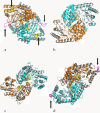Type I pyridoxal 5'-phosphate dependent enzymatic domains embedded within multimodular nonribosomal peptide synthetase and polyketide synthase assembly lines
- PMID: 24148833
- PMCID: PMC3870968
- DOI: 10.1186/1472-6807-13-26
Type I pyridoxal 5'-phosphate dependent enzymatic domains embedded within multimodular nonribosomal peptide synthetase and polyketide synthase assembly lines
Abstract
Background: Pyridoxal 5'-phosphate (PLP)-dependent enzymes of fold type I, the most studied structural class of the PLP-dependent enzyme superfamily, are known to exist as stand-alone homodimers or homotetramers. These enzymes have been found also embedded in multimodular and multidomain assembly lines involved in the biosynthesis of polyketides (PKS) and nonribosomal peptides (NRPS). The aim of this work is to provide a proteome-wide view of the distribution and characteristics of type I domains covalently integrated in these assemblies in prokaryotes.
Results: An ad-hoc Hidden Markov profile was calculated using a sequence alignment derived from a multiple structural superposition of distantly related PLP-enzymes of fold type I. The profile was utilized to scan the sequence databank and to collect the proteins containing at least one type I domain linked to a component of an assembly line in bacterial genomes. The domains adjacent to a carrier protein were further investigated. Phylogenetic analysis suggested the presence of four PLP-dependent families: Aminotran_3, Beta_elim_lyase and Pyridoxal_deC, occurring mainly within mixed NRPS/PKS clusters, and Aminotran_1_2 found mainly in PKS clusters. Sequence similarity to the reference PLP enzymes with solved structures ranged from 24 to 42% identity. Homology models were built for each representative type I domain and molecular docking simulations with putative substrates were carried out. Prediction of the protein-protein interaction sites evidenced that the surface regions of the type I domains embedded within multienzyme assemblies were different from those of the self-standing enzymes; these structural features appear to be required for productive interactions with the adjacent domains in a multidomain context.
Conclusions: This work provides a systematic view of the occurrence of type I domain within NRPS and PKS assembly lines and it predicts their structural characteristics using computational methods. Comparison with the corresponding stand-alone enzymes highlighted the common and different traits related to various aspects of their structure-function relationship. Therefore, the results of this work, on one hand contribute to the understanding of the functional and structural diversity of the PLP-dependent type I enzymes and, on the other, pave the way to further studies aimed at their applications in combinatorial biosynthesis.
Figures





Similar articles
-
In silico analysis of methyltransferase domains involved in biosynthesis of secondary metabolites.BMC Bioinformatics. 2008 Oct 25;9:454. doi: 10.1186/1471-2105-9-454. BMC Bioinformatics. 2008. PMID: 18950525 Free PMC article.
-
Structural elements of an NRPS cyclization domain and its intermodule docking domain.Proc Natl Acad Sci U S A. 2016 Nov 1;113(44):12432-12437. doi: 10.1073/pnas.1608615113. Epub 2016 Oct 17. Proc Natl Acad Sci U S A. 2016. PMID: 27791103 Free PMC article.
-
Evolutionary imprint of catalytic domains in fungal PKS-NRPS hybrids.Chembiochem. 2012 Nov 5;13(16):2363-73. doi: 10.1002/cbic.201200449. Epub 2012 Sep 28. Chembiochem. 2012. PMID: 23023987
-
Protein-protein interactions in polyketide synthase-nonribosomal peptide synthetase hybrid assembly lines.Nat Prod Rep. 2018 Nov 14;35(11):1185-1209. doi: 10.1039/c8np00022k. Nat Prod Rep. 2018. PMID: 30074030 Review.
-
The structural biology of biosynthetic megaenzymes.Nat Chem Biol. 2015 Sep;11(9):660-70. doi: 10.1038/nchembio.1883. Nat Chem Biol. 2015. PMID: 26284673 Review.
Cited by
-
The Neuromodulator-Encoding sadA Gene Is Widely Distributed in the Human Skin Microbiome.Front Microbiol. 2020 Dec 1;11:573679. doi: 10.3389/fmicb.2020.573679. eCollection 2020. Front Microbiol. 2020. PMID: 33335515 Free PMC article.
-
Acyltransferases as Tools for Polyketide Synthase Engineering.Antibiotics (Basel). 2018 Jul 18;7(3):62. doi: 10.3390/antibiotics7030062. Antibiotics (Basel). 2018. PMID: 30022008 Free PMC article. Review.
-
Current Advances on Structure-Function Relationships of Pyridoxal 5'-Phosphate-Dependent Enzymes.Front Mol Biosci. 2019 Mar 5;6:4. doi: 10.3389/fmolb.2019.00004. eCollection 2019. Front Mol Biosci. 2019. PMID: 30891451 Free PMC article. Review.
-
Structural insights into the catalytic mechanism of Bacillus subtilis BacF.Acta Crystallogr F Struct Biol Commun. 2020 Mar 1;76(Pt 3):145-151. doi: 10.1107/S2053230X20001636. Epub 2020 Mar 3. Acta Crystallogr F Struct Biol Commun. 2020. PMID: 32134000 Free PMC article.
-
Evolutionary Trails of Plant Group II Pyridoxal Phosphate-Dependent Decarboxylase Genes.Front Plant Sci. 2016 Aug 23;7:1268. doi: 10.3389/fpls.2016.01268. eCollection 2016. Front Plant Sci. 2016. PMID: 27602045 Free PMC article. Review.
References
-
- Schneider G, Kack H, Lindqvist Y. The manifold of vitamin B6 dependent enzymes. Structure. 2000;8:R1–R6. - PubMed
-
- Clayton PT. B6-responsive disorders: a model of vitamin dependency. J Inherit Metab Dis. 2006;29:317–326. - PubMed
-
- Eliot AC, Kirsch JF. Pyridoxal phosphate enzymes: mechanistic, structural, and evolutionary considerations. Annu Rev Biochem. 2004;73:383–415. - PubMed
-
- Denessiouk KA, Denesyuk AI, Lehtonen JV, Korpela T, Johnson MS. Common structural elements in the architecture of the cofactor-binding domains in unrelated families of pyridoxal phosphate-dependent enzymes. Proteins. 1999;35:250–261. - PubMed
Publication types
MeSH terms
Substances
LinkOut - more resources
Full Text Sources
Other Literature Sources
Research Materials
Miscellaneous

